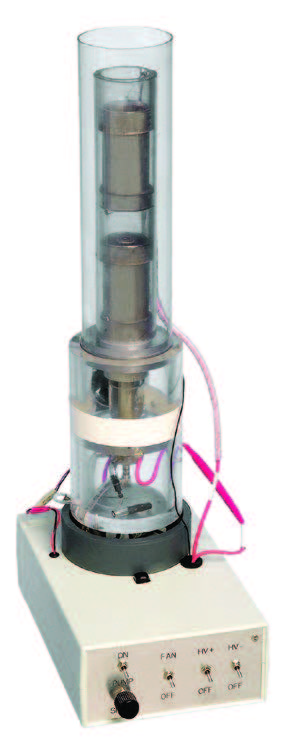Tech Briefs
Savannah River National Laboratory
Aerosol-to-Liquid Particle Extraction System
A new device uses electrostatic precipitation to collect and concentrate airborne agents in a liquid sample for onsite or laboratory analysis. The collection efficiency is 85 percent to 92 percent depending on the size of the particles. The Aerosol-to-Liquid Particle Extraction System (ALPES) is designed to collect chemical agents; radioactive particles; microorganisms such as spores, bacteria, and fungi; and molecules and other substances associated with explosives.
At a glance
- Collects microorganisms, chemical agents, radioactive particles
- Collection efficiency of >90 percent
- Collects particles of < 0.3 to 10 micron diameters
- Maintains viability of live agents
- 300 liters per minute flow rate
- Consumes <12 watts of power
- Uses a 12 volt battery
- Measures 6” x 10” x 21”
- U.S. Patent 6,955,075
New device collects deadly agents for quick identification
Agents that could be used in chemical and biological warfare tend to disperse widely in the air when released. Quickly collecting a concentrated sample of these agents is critical to detecting them before they reach harmful dose levels in the air. Also, methods of detection such as by polymerase chain reaction are enhanced when the collected agents remain alive. Other collection devices using wet cyclone designs are larger and heavier, have higher power demands, and are noisy, thereby precluding unobtrusive uses. Devices using impactors for collection do not maintain the viability of live agents.

Uses proven particle separation technique
The new ALPES takes advantage of the long-proven use of wet electrostatic precipitation to separate particles from air. The device comprises an ionization section atop a tubular collection electrode enclosed in a column. A pump pulls air through the vertical column at a flow rate of up to 300 liters a minute.
Recirculating liquid concentrates collected agents
A reservoir at the bottom of the column contains liquid that is pumped up through the inside of the collection tube, which is charged at 8,000 volts. The liquid flows over the top of the charged tube and down the sides, collecting the ionized particles from the outside surface of the tube. The flow rate maintains a continuous film of liquid on the outer surface of the tube. Constant recirculation of the liquid through the tube concentrates the collected particles.
A valved sample loop enables diversion of the liquid to an online analyzer or to a sample vial for transport to a laboratory for analysis.
Low power, quiet operation
With minimal pressure drop, the device consumes less than 12 watts of power and operates quietly.
Adaptable for selected analyses
The recirculating liquid can be customized for specific situations. A buffered saline solution or a nutrient solution will maintain biological agents in a viable state, enabling faster and more accurate analyses.
Partnering Opportunities
SRNL invites interested companies with proven capabilities in this area of expertise to enter into a licensing agreement with SRNL to market this nuclear material detection system. Interested companies will be requested to submit a business plan setting forth company qualifications, strategies, activities, and milestones for commercializing this invention.
Qualifications should include past experience at bringing similar products to market, reasonable schedule for product launch, sufficient manufacturing capacity, established distribution networks, and evidence of sufficient financial resources for product development and launch.
Download Tech Brief
Contact Information
Savannah River National Laboratory
E-mail: partnerships@srnl.doe.gov